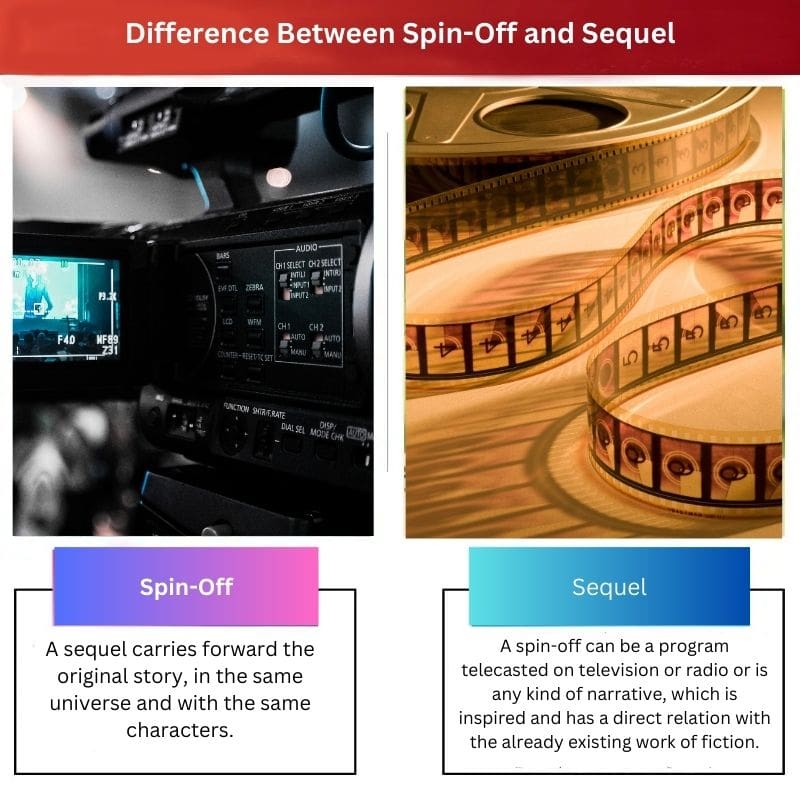A spin-off branches off from the original story, focusing on different characters or settings within the same universe, offering fresh perspectives or narratives. In contrast, a sequel directly continues the storylines and characters from the original work, expanding upon established themes and plotlines while maintaining continuity with the preceding installment.
Key Takeaways
- Spin-offs focus on a secondary character or storyline from the original work, creating a new narrative; sequels continue the main story or characters from the original.
- Spin-offs can be independent of the original story, while sequels are linked directly to the events of the original.
- A spin-off can exist in various forms, such as movies, TV shows, or books; sequels are a continuation of the original in the same medium.
Spin-Off vs Sequel
Spin off defines the storyline of the original show or movie. A spin off can also be a show or movie linked with the existing show. Puss in boots is an example of spin off. Sequel continues to define the events of the original storyline. More details related to the story are added in a sequel. Harry potter and goblet of fire is an example of a sequel.

In general cases, the sequel carries forward the original story, in the same universe and with the same characters. The amount of risk involved in determining the success of a sequel is comparatively low than making a new movie in another universe.
There are different types of formats for the name of the sequels. Generally, they have unrelated titles and, sometimes the tiles are similar to the already existing movie.
Comparison Table
| Feature | Spin-Off | Sequel |
|---|---|---|
| Relation to Original Work | Derives from an existing work but focuses on a different story or set of characters | Follows the same story after the events of the original work and features the original characters (or their descendants) |
| Continuity | May have some references or connections to the original work, but the main story can be understood without prior knowledge | Directly continues the story from the original work, and understanding the original is necessary to follow the plot |
| Characters | May include characters from the original work in a supporting role, but the main focus is on new characters | Features the original main characters (or their descendants) who may be older or in different situations |
| Setting | May be the same as the original work, but can also be entirely new | Typically takes place in the same fictional universe as the original work, but at a later point in time |
| Examples | * “Better Call Saul” (spin-off of “Breaking Bad”) * “Fast & Furious: Hobbs & Shaw” (spin-off of the “Fast & Furious” franchise) | * “Star Wars: Episode II – Attack of the Clones” (sequel to “Star Wars: Episode I – The Phantom Menace”) * “The Hunger Games: Catching Fire” (sequel to “The Hunger Games”) |
| Purpose | To expand on the existing fictional universe and introduce new stories and characters | To continue the story of the original work and explore the further adventures of the original characters |
What is Spin-Off?
Definition:
A spin-off refers to a derivative work that branches off from the original narrative, introducing new characters, storylines, or settings while retaining connections to the parent material. These offshoots delve into previously unexplored aspects of the fictional universe, offering fresh perspectives and expanding the overarching narrative landscape.
Characteristics:
- Continuity with Original Material: Spin-offs maintain a sense of continuity with the source material, referencing events, characters, or settings from the parent narrative. This continuity helps to establish a familiar foundation for both existing fans and newcomers, ensuring a cohesive experience within the established universe.
- New Focus: While spin-offs retain connections to the original story, they shift focus onto secondary characters, peripheral settings, or untapped storylines. By exploring these alternative narratives, spin-offs can provide audiences with a deeper understanding of the fictional world and its inhabitants, enriching the overall storytelling experience.
- Creative Exploration: Spin-offs offer creators the opportunity to experiment with new ideas, genres, or storytelling techniques within a familiar framework. This creative freedom allows for the exploration of diverse themes and narratives, catering to a broader range of audience interests while maintaining the essence of the original material.
- Expanding the Universe: Beyond simply revisiting familiar territory, spin-offs aim to expand the boundaries of the fictional universe, introducing new dimensions, cultures, or conflicts that contribute to the overarching narrative tapestry. By broadening the scope of the narrative landscape, spin-offs can rejuvenate established franchises and attract new audiences.
Examples:
- “Better Call Saul” (Spin-off of “Breaking Bad”): This acclaimed series explores the backstory of Saul Goodman, a supporting character from “Breaking Bad,” offering insight into his transformation from a struggling lawyer to a morally compromised legal fixer.
- “Rogue One: A Star Wars Story” (Spin-off of the Star Wars saga): Set in the same galaxy far, far away as the main Star Wars saga, “Rogue One” tells the story of a group of rebels who undertake a daring mission to steal the plans for the Death Star, providing context and depth to the events leading up to the original 1977 film, “Star Wars: Episode IV – A New Hope.”
- “Fantastic Beasts and Where to Find Them” (Spin-off of the Harry Potter series): This film series, based on a fictional textbook mentioned in the Harry Potter novels, explores the adventures of Newt Scamander, a magizoologist, in the wizarding world decades before the events of the original series, expanding the lore and mythology of J.K. Rowling’s magical universe.

What is Sequel?
Definition:
A sequel is a subsequent installment in a series or franchise that directly continues the storylines, characters, and themes established in the original work. Sequels build upon the foundation laid by their predecessors, further developing the narrative trajectory and exploring new avenues within the established universe.
Characteristics:
- Continuation of Storylines: Sequels pick up where the original work left off, continuing the arcs of central characters and unresolved plot threads. This continuity allows audiences to follow the ongoing journeys of familiar protagonists, witnessing their growth, challenges, and triumphs as the narrative unfolds.
- Expansion of Universe: While sequels maintain continuity with the original material, they also expand the boundaries of the fictional universe, introducing new locations, characters, and conflicts that enrich the storytelling experience. By broadening the scope of the narrative landscape, sequels offer audiences fresh perspectives and opportunities for exploration within familiar settings.
- Evolution of Themes: Sequels delve deeper into the themes and motifs introduced in the original work, exploring them from different angles or presenting new variations. Through nuanced character development and intricate plot dynamics, sequels offer audiences deeper insights into the underlying themes of the series, fostering richer engagement and interpretation.
- Maintaining Consistency: While sequels may introduce new elements and narrative twists, they strive to maintain consistency with the tone, style, and ethos of the original work. This consistency helps to preserve the integrity of the franchise, ensuring that sequels resonate with the established fan base while also appealing to new audiences drawn to the series.
Examples:
- “The Empire Strikes Back” (Sequel to “Star Wars: Episode IV – A New Hope”): Widely regarded as one of the greatest sequels of all time, “The Empire Strikes Back” continues the epic saga of the Rebel Alliance’s struggle against the tyrannical Galactic Empire, further developing the characters introduced in the original film and expanding the scope of the Star Wars universe.
- “The Dark Knight” (Sequel to “Batman Begins”): Directed by Christopher Nolan, “The Dark Knight” follows the titular vigilante as he faces off against the chaotic Joker in a battle for the soul of Gotham City. Building upon the themes of fear, justice, and morality established in “Batman Begins,” this sequel explores the darker, more complex aspects of the Batman mythos.
- “Harry Potter and the Chamber of Secrets” (Sequel to “Harry Potter and the Philosopher’s Stone”): This second installment in J.K. Rowling’s beloved series follows young wizard Harry Potter as he returns to Hogwarts School of Witchcraft and Wizardry for his second year, facing new challenges and uncovering dark secrets hidden within the school’s walls.

Main Differences Between Spin-Off and Sequel
- Continuity with Original Work:
- Spin-offs branch off from the original narrative, exploring new characters or settings within the same universe.
- Sequels directly continue the storylines, characters, and themes established in the original work.
- Focus and Perspective:
- Spin-offs shift focus onto secondary characters, peripheral settings, or untapped storylines.
- Sequels primarily focus on the ongoing journeys of central characters and unresolved plot threads.
- Narrative Expansion:
- Spin-offs aim to expand the boundaries of the fictional universe by introducing new dimensions, cultures, or conflicts.
- Sequels expand upon the existing narrative trajectory, deepening themes and exploring new avenues within the established universe.
- Creative Freedom:
- Spin-offs offer creators the opportunity to experiment with new ideas, genres, or storytelling techniques within a familiar framework.
- Sequels maintain consistency with the tone, style, and ethos of the original work while evolving themes and motifs.





